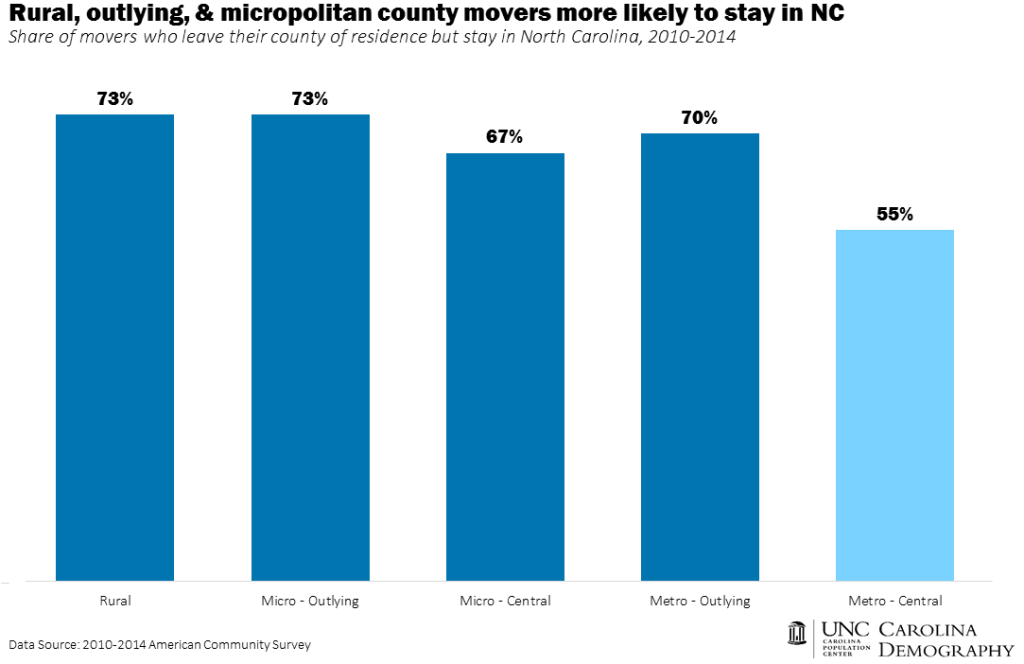Written by Dr. Rebecca Tippett and originally published at Carolina Demography. This continues our series of posts highlighting some of Rebecca’s excellent insights into rural North Carolina. If you missed last week’s post, be sure to go back and check it out as well.
“The growth of urban places historically has been fueled largely by in-migration from rural areas (including from other countries)…” – Daniel Lichter & David Brown, “Rural America in an Urban Society”
Nearly half of North Carolina’s counties – 47 of 100 – had net out-migration between 2010 and 2015, meaning more people moved away than moved in.
There are some clear patterns to this movement. The core counties of the state’s major metropolitan areas—such as Guilford (Greensboro), Forsyth (Winston-Salem), Mecklenburg (Charlotte), and Wake (Raleigh)—saw net in-migration. In general, the counties immediately adjacent to these core counties, such as Johnston and Harnett south of Wake, also experienced net in-migration. In addition, regions that are generally attractive to retirees, such as Western North Carolina and the coastal counties, have had net in-migration since 2010.
Meanwhile, many of the counties that have experienced net out-migration are on the periphery of larger metro areas, are located in smaller metropolitan or micropolitan regions, or are rural counties, meaning they belong to neither a metropolitan nor micropolitan region. (A map of North Carolina’s metropolitan and micropolitan statistical areas is available here and the delineation files are available here.)
But even though many counties have experienced net out-migration, North Carolina is a “sticky” state. Most people born here still live here. Among North Carolina-born adults, 72% still live here, the highest share of any other state except for Texas. And, when we look at individuals who move out of their county, individuals from rural, outlying, and micropolitan counties are much more likely to stay in North Carolina.
The chart below uses 2010-2014 American Community Survey data on geographic mobility in the prior year in conjunction with the Office of Management and Budget’s definition of central and outlying counties by metropolitan and micropolitan regions. Among the state’s most rural counties—counties in neither a metropolitan or micropolitan region—nearly 3 of 4 movers (73%) who move out of the county move elsewhere in the state. The same proportion of individuals who leave outlying micropolitan counties, such as Camden County (outlying to the Elizabeth City micropolitan statistical area), stay in North Carolina (73%).
Central micropolitan counties include counties like Surry, home to Mt. Airy. In these counties, two-thirds (67%) of individuals who leave the county stay in the state. Among outlying metro counties, such as Rockingham County (outlying to Greensboro-High Point metro), 70% of movers stay in the state.
In contrast, only 55% of individuals who move away from central metropolitan counties – such as Mecklenburg, Wake, and Durham – stay in the state.
These are data and charts initially shared with attendees at Golden LEAF’s recent “All in NC” event as part of a broader discussion to highlight the interdependence of rural and urban communities. Whether a region is experiencing population growth or population decline, each of these demographic trends poses challenges. And while the challenges are distinct, they are interrelated. Across North Carolina, population growth in urban areas is fueled, in part, by net out-migration that can create population losses in rural communities.
Rebecca Tippett, Ph.D, is the Director of Carolina Demography at the Carolina Population Center at UNC-Chapel Hill where she translates demographic and economic data into specific, usable information and knowledge to inform decision-making, evaluation, and policy. Her work has included forecasting population trends to determine the demand for new schools, identifying target locations for new businesses, evaluating population estimation methods for the U.S. Census Bureau, and examining demographic and labor market factors associated with employee turnover. She regularly writes and presents about the impact of demographic and social trends in North Carolina.
Carolina Demography is a demographic consulting service at the Carolina Population Center at UNC-Chapel Hill. They provide a full array of demographic data and research services for North Carolina businesses, foundations, government agencies, schools, not-for-profit organizations, and many more. Contact them today to setup a free initial consultation.


